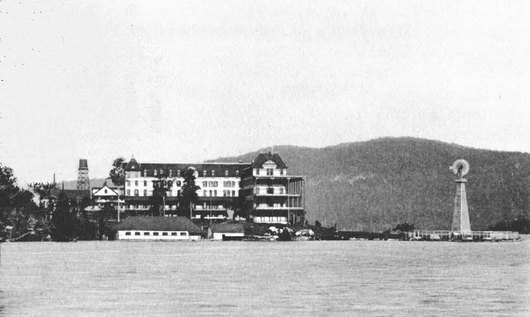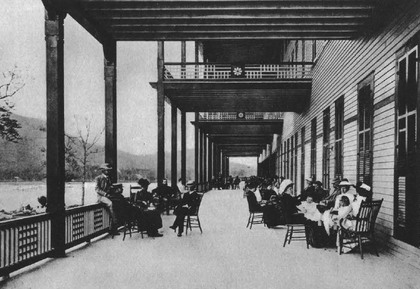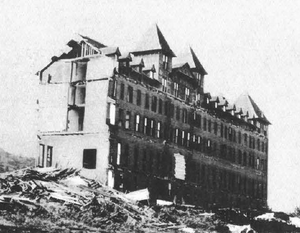Prospect House (Hamilton County, New York) facts for kids
Prospect House was a huge, fancy hotel with 300 rooms. It opened in 1882 at Blue Mountain Lake in New York state. Rich people from America and all over the world loved to stay there. It was the biggest hotel in the Adirondacks in the late 1800s.
What made it super special? It was the first hotel in the world to have electric lights in every guest room! The famous inventor Thomas Edison himself helped design the electrical system. He even set up two special machines called dynamo electric generators to make the electricity. Sadly, the hotel only stayed open for a short time each year. Because of high costs, it closed down by 1903.
Contents
How Prospect House Began
Prospect House was built where a smaller guesthouse used to be. This guesthouse belonged to James and Mary Ordway. They built it in 1877 on a piece of land called Prospect Point. This land stuck out into Blue Mountain Lake.
The Ordways' guesthouse was made of wood and had two and a half stories. It could hold about thirty guests. In 1879, the guesthouse was renamed American House. It was then sold to Frederick C. Durant. He was connected to a sugar-making business in New York City. Frederick's uncle, Thomas C. Durant, was a railroad boss who liked building things in the Adirondacks. Frederick thought it was a great idea. He planned to build a huge, fancy 300-room hotel on the land he bought.
Building the Grand Hotel
Work on the new hotel's foundation started in the fall of 1880. In the spring of 1881, Durant set up a sawmill right at the building site. This helped them cut all the wood needed for the new hotel. The hotel was designed to look like a "T" shape. The top part of the "T" was 255 feet (78 meters) long. It faced the beautiful lake. The long part of the "T" was 158 feet (48 meters) long. It connected to the back of the Ordways' original guesthouse.
A wide porch, called a veranda, wrapped around the front and sides. It was 20 feet (6 meters) wide and 370 feet (110 meters) long. The hotel's design looked a lot like the Grand Union Hotel in Saratoga Springs, New York.
The six-story hotel opened in the summer of 1882. It was built in the Queen Anne style. The biggest and best rooms were on the main floor. Guests had lots of fun things to do. There was a restaurant, a bowling alley, and a billiard room. They could also enjoy a shooting gallery, golf, and lawn tennis. For convenience, the hotel had a barber shop, a mail room, and a telegraph office. There was even a library, a doctor's office, and a pharmacy. An orchestra played music every day for the guests.
Modern Features and Travel
Prospect House was the biggest hotel in the Adirondacks at that time. It was about 30 miles (48 kilometers) from the nearest railroad. Guests would travel by train first. Then, they would switch to a stagecoach. This coach took them to the lake. From there, they took a boat to Prospect Point, right where the hotel was.
All 300 rooms had running water and steam heat. The steam heat came from pipes hidden in wooden boxes. Guests could open the box cover if they were cold. They would close it when the room got warm. The hotel also had a steam elevator, a deer corral, a windmill, a water tower, and a boathouse.
Thomas Edison personally oversaw the electrical system design for the hotel. G. W. Waters was the electrical engineer. Edison and Waters made sure every room had incandescent electric light when the hotel opened in 1882. This made it the first hotel anywhere with electric lights in all guest bedrooms! The electricity came from two special Edison dynamo machines. People called these dynamos the 'long-waisted Mary Ann.' This was because they had two tall, upright poles about 5 feet (1.5 meters) high.
Famous Visitors
The hotel's guest book showed that some of the richest people in the world stayed at Prospect House year after year. Most guests were Americans from the Mid-Atlantic states. But sometimes, visitors came from far-off places like London, St. Petersburg, and Tokyo. In 1893, a Spanish duke named Cristobal Colón y de La Cerda, 14th Duke of Veragua stayed there. He was a descendant of Christopher Columbus! He was visiting America to celebrate the 400th anniversary of Columbus's 1492 journey.
Why the Hotel Closed
Several things led to the closing of this grand Adirondack hotel. One big problem was the high cost of running such a fancy place. The hotel was only open for a short summer season. Another issue was how hard it was to get there. The Delaware and Hudson Railway stopped its special train service from New York City to North Creek, New York. This train used to save guests many hours of travel.
Also, more hotels started opening in the Adirondacks. Many guests chose newer hotels that were easier to reach. There were also a few cases of typhoid fever in the area. This made many people afraid to visit. The Panic of 1893, a time of economic trouble, also hurt the hotel. The owner, Durant, borrowed a lot of money from his brother Howard to keep the business going.
Eventually, his brother Howard took over the hotel in 1897. He renamed it Hotel Utowana. But the high costs, difficult travel, and poor management continued. The hotel lost more and more money. It finally closed for good in 1903. All its furniture was sold off, and the building was torn down in 1915.





